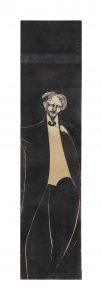At the upcoming PAN (14-21 november) Ubbens Art (booth 112) offers several rare symbolist
works  which might interest the readers of this website. One of them is Et Satan conduit le Bal by Karel de Nerée about which Sander Bink wrote the text below, which we reproduce here with kind permission of the author and mr. Ubbens.
which might interest the readers of this website. One of them is Et Satan conduit le Bal by Karel de Nerée about which Sander Bink wrote the text below, which we reproduce here with kind permission of the author and mr. Ubbens.
**
C.K.H. de Nerée tot Babberich (Dutch, 1880-1909) ‘Et Satan conduit le Bal’. [1903]; East Indian ink on paper, 35,1 x 8,3 cm.
Provenance: Mak van Waay, Amsterdam, ‘Atelier de l’artiste peintre C.K.H. de Nere?e tot Babberich, 2eme partie, March 1933, cat. no. 16; Paul Brandt Art & Auctions, Amsterdam ; Private collection, The Netherlands.
Exhibition: ‘Nagelaten werken Karel de Nerée tot Babberich’, Arnhem, Vereniging voor Beeldende Kunst, 1951, cat. no. 74
A remarkable ‘decadent’ drawing of an elegantly dressed Satan by the talented symbolist draughtsman. It can probably be dated 1903, which makes it a rare work, as De Nerée only made about maybe ten to twenty more or less finished works that year because he was too ill from the tbc to work at his art. The main part of the 1903 works are characterized by the use of large black surfaces, like Satans suit here. The style is also somewhat similar to the various grotesques and caricature’s De Nerée made in 1903-’04.
The title stems from a refrain by Méphistophélès in Charles Gounods 1859 opera Faust. In the years around 1900 (parts of) the opera weere often performed at Scheveningens Kurhaus, where De Nerée must have heard the song.
The figure and composition seems to be inspired by the drawings of Félicien Rops, especially his Le Vice Supreme (1884) and The Sphinx (1882). This inspiration makes it quite unique in Dutch art from around 1900 as Rops’ work was generally considered too avantgarde, too pornographic to mention. De Nerée probably got acquainted with Rops via the frontispieces and illustrations he made for De Nerée’s much admired symbolist writers like Mallarmé or Verlaine. The title Et Satan conduit le Bal also echoes Rops’ Satan semant l’Ivraie (1867). The Satan theme returns more often in De Nerée’s oeuvre, for example in the 1904 ink drawing Diablerie (Museum Arnhem). There is a touch of Aubrey Beardsley in the drawing, as the lines and figures are somewhat similar to Beardsley’s ink drawing The Wagnerites
According to some witnesses De Nerée himself was ‘evil’. At least that how his friend the writer Henri van Booven characterizes De Nerée’s literary alter ego ‘De Lacey’ in his novel De Fraaie Comedie (1912, The Superb Comedy). And in an 1910 essay about ‘the demonic in art’ the art critic Albert Plasschaert states that in De Nerée’s work the ‘evilness of the sensual’ is to be found. But there is nothing bad or evil about this fine piece of art.
